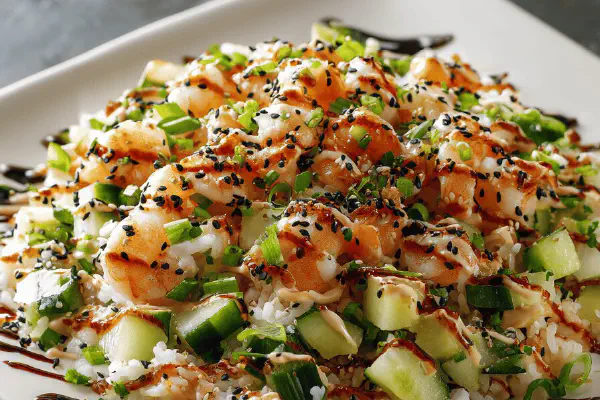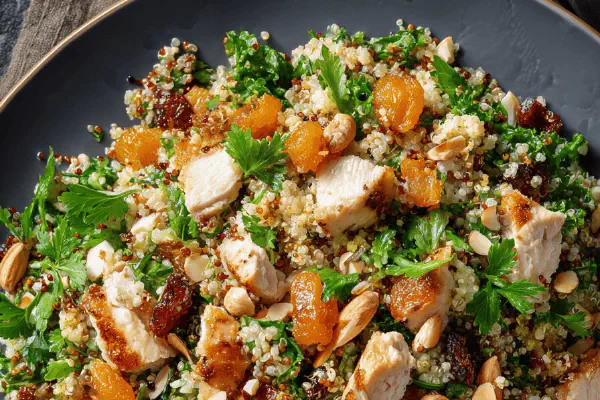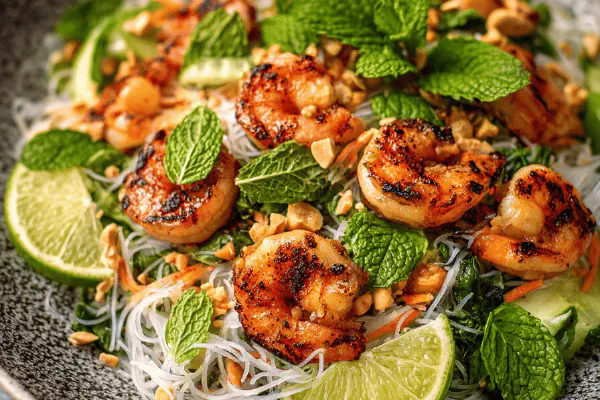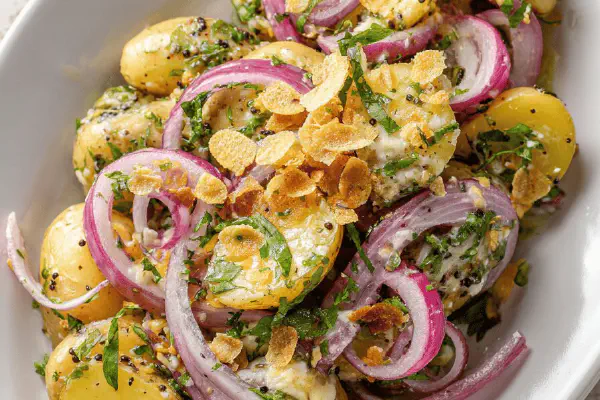Nordic Shrimp Tartare Salad

By Emma
Certified Culinary Professional
Ingredients
Rice
- 370 g (about 1 2/3 cups) sushi rice (Calrose or similar medium-grain)
- 460 ml (just under 2 cups) water
- 35 ml (2 1/3 tablespoons) rice vinegar
- 12 ml (just under 1 tablespoon) sugar
- 2 ml (about 1/3 teaspoon) fine salt
Shrimp Tartare Salad
- 2 Persian cucumbers, finely diced
- 3/4 Asian pear (peeled and cored), finely diced
- 2 green onions, finely sliced
- 25 ml (1 2/3 tablespoons) toasted sesame oil
- 20 ml (1 1/3 tablespoons) fresh lime juice
- 10 ml (2 teaspoons) chopped pickled ginger
- 400 g (14 oz) Nordic shrimp fresh or thawed, shelled, patted dry
- 50 ml (about 3 tablespoons) sesame mayo-style dressing
- 45 ml (3 tablespoons) ready-made teriyaki sauce (optional)
- Toasted black and white sesame seeds for garnish
About the ingredients
Method
Rice
- Rinse rice repeatedly under cold water until the water runs clear; drain thoroughly. The starch rinsing is key for non-clumpy rice.
- Combine rice and water in a heavy-bottomed pot, bring to a vigorous boil. Then reduce to the lowest simmer, cover tightly. Important: no peeking. Cook for around 13 minutes. Listen for gentle boiling, feel pot base; bubbling should reduce but rice should not stick.
- Remove from heat, keep covered, let steam undisturbed for 7 minutes. You’ll feel rice shift texture, becoming fluffier and shoulders of grains separating.
- While rice rests, mix vinegar, sugar, and salt in a small bowl until completely dissolved. Warm rice slightly if cool; fold vinegar mixture gently but thoroughly into rice with a fork, fluffing grains but not smashing. Let it cool to room temp — crucial for perfect texture, no mush.
Shrimp Tartare Salad
- Dice cucumbers and pear into small, uniform cubes. Size matters for clean texture contrast. Slice green onions thin — the sharp freshness is vital.
- In a large bowl, toss cucumbers, pears, and onions with sesame oil, lime juice, and chopped pickled ginger. The oil carries aroma, ginger adds brightness and subtle heat; balance to taste.
- Add the shrimp — if frozen, ensure fully thawed and patted bone-dry. Water will kill texture and dilute flavors. Salt lightly to enhance the shrimp’s natural brininess. Toss gently but fully combined.
- To plate: use a round mold of about 4 1/2 inches diameter. Press about one-quarter of the rice into base. Tackiness of rice should hold shape. Spoon shrimp salad atop rice gently — don’t squish or push.
- Drizzle sesame mayo in thin lines or dollops over salad, optionally a thin shimmer of teriyaki to add complex umami and a little sweetness. Finish with a generous sprinkle of toasted black and white sesame seeds for crunch and visual contrast.
- Serve immediately. The combination of warm rice with cool crisp salad hits great mouthfeel.
Notes and Tips
- Got no sushi rice? Use short to medium grain rice but adjust water ratio and watch cooking closely; less starchy rice means different bite.
- No Asian pear? Substitute with firm apple like Fuji or Gala for similar sweet crunch.
- No pickled ginger? Fresh grated ginger with a dash of rice vinegar can mimic acid brightness.
- For mayo, simple Japanese Kewpie or homemade mayo whisked with sesame oil works.
- Teriyaki optional but recommended for depth; use a good bottled or quick reduction of soy sauce, mirin, and sugar if preferred.
- If pressed for time, use a rice cooker with a sushi setting; just stir in vinegar mix while hot.
- Don’t skip resting rice. Rushing results in undercooked or gluey grains, kills the texture balance essential for this dish.
- Serve with chopsticks or small forks; texture interplay evident in every bite.
Cooking tips
Chef's notes
- 💡 Rinse sushi rice violently till water runs clear; you want minimal starch but not over-washed or grains go too soft or dry. Use a heavy pot with tight lid; steam trapped is key. No peeking here or rice texture suffers. Listen for gentle bubbling sound. Bake time around 13 minutes with 7 resting makes grains separate but sticky enough to mold — important for layering shrimp salad on top.
- 💡 Dice cucumbers and Asian pear small and uniform; size contrast hugely impacts texture here. Pear is sweet but subtle, Fuji apple swap changes acidity, watch that. Green onions sliced thin to keep sharpness but not overpower. Mix dressing separately to test lime and ginger balance; too much lime kills the mellow sweet. Toasted sesame oil has nutty aromas you can smell, don't sub olive oil unless flavor willingness is low.
- 💡 Shrimp needs to be dry. Fresh or thawed, paper towel is essential or salad becomes watery instead of crunchy. Salt shrimp lightly to pull sweetness forward, toss gently to keep pieces intact. Mayo drizzle is mostly umami and cream, not fat overload — homemade mayo with toasted sesame oil whips up fast if store-bought too thick. Teriyaki optional but adds unexpected caramel sweetness layer, thin lines work better than pools to avoid soggy salad.
- 💡 Plating involves a mold to shape rice base tightly but avoid smashing; rice stickiness should hold but no mush. Spoon salad gently; pressing ruins bite and mouthfeel. Toast black and white sesame seeds carefully; burnt seeds make bitterness that sticks in throat. Sprinkle last. Serve immediately to maintain contrast between warm rice and cool salad. Delayed serving means limp veggies and gummy rice; if necessary separate components and combine just before eating.
- 💡 Rice vinegar-sugar-salt mix must dissolve fully before folding into warm rice but folding — no stirring or smashing grains. Vinegar temp tolerances critical; too hot dissolves grains, too cool leaves uneven flavor. Folding with fork or paddle, fluff and air grains gently. Rice resting after cooking, the quiet steam pauses set moisture distribution, waits for flavor soak. Skipping rest kills texture. Patience yields dry, fluffy, but sticky rice bed.
Common questions
Can I substitute Asian pear?
Fuji apple works well. Texture crunch is key. Fruit sweetness varies so adjust lime juice downward for sweeter fruit. Avoid soft fruits like ripe pear or nectarine; mush ruins salad contrast. Some try jicama but flavor differs. Asian pear feels fresh with faint grain, essential to counter shrimp brine.
What if rice clumps?
Rinsing step often missed or rushed. Rinse cold water, swirl, drain repeat until water clears. Use heavy pot, consistent low simmer. If rice clumps, not enough airflow or over stirring during folding. Also check vinegar mix fully dissolved; sugar crystals cause uneven moisture. Cooling rice to room temp before salad assembly is crucial to stop clumping continuing.
Shrimp too wet how to fix?
Pat dry with paper towels multiple times. Excess water kills crunch, dilutes flavors. If frozen, thaw fully in fridge overnight, not in water. Salt pulls moisture; add lightly just before salad mixing. Toss gently not vigorously to keep textures. If shrimp still wet, drain briefly on rack or dry in open bowl fridge to pull surface moisture.
How to store leftovers?
Rice and shrimp salad separate containers best to avoid sogginess. Rice cools completely then covered tightly; fridge only good for day or two. Salad with mayo gets softer, flavors meld but veggies lose crispness. Bring rice back close to room temp before serving again, no microwave for rice or it gets gummy. No freezing advised for texture reasons.



